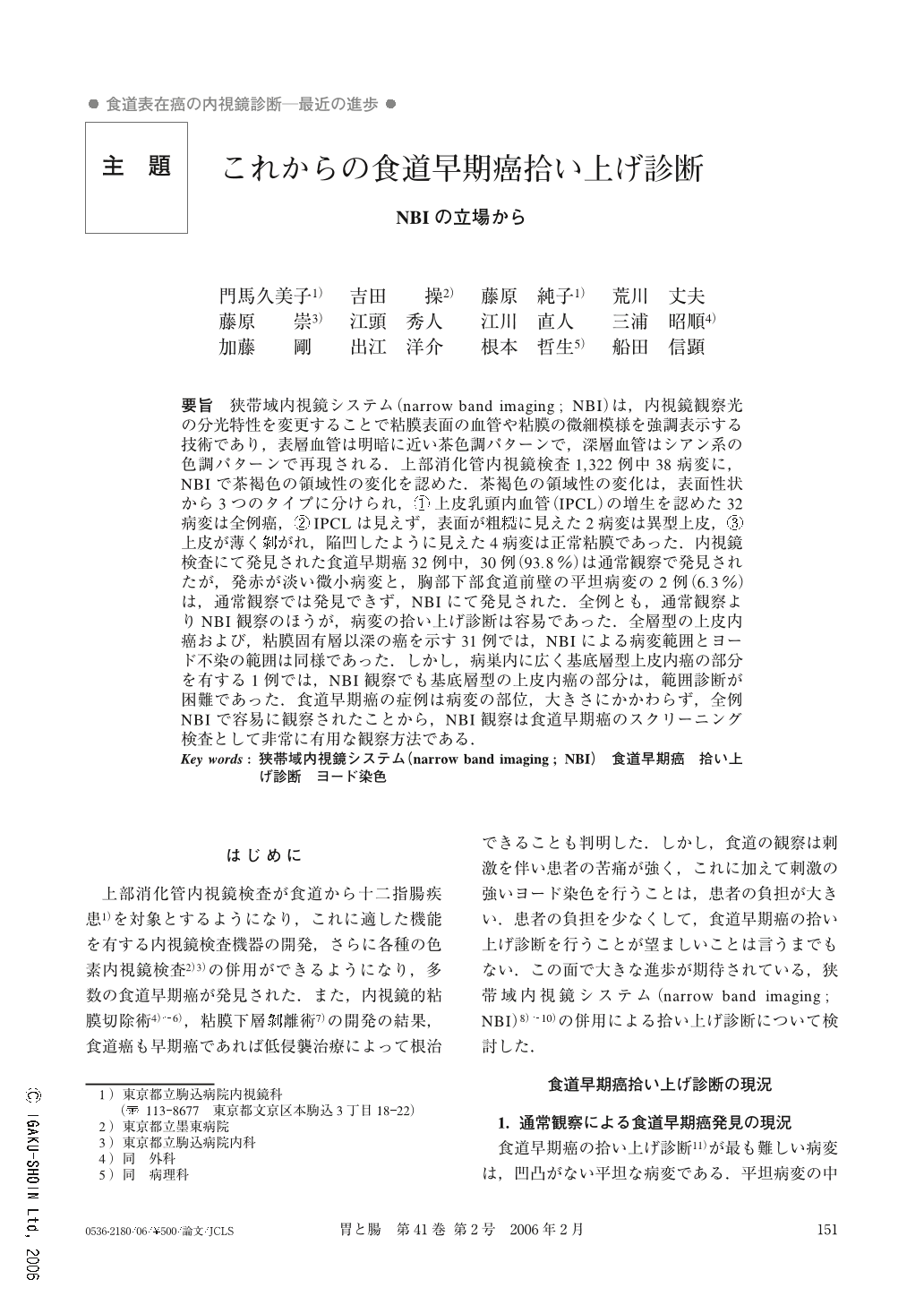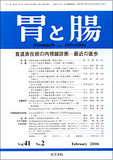Japanese
English
- 有料閲覧
- Abstract 文献概要
- 1ページ目 Look Inside
- 参考文献 Reference
- サイト内被引用 Cited by
要旨 狭帯域内視鏡システム(narrow band imaging ; NBI)は,内視鏡観察光の分光特性を変更することで粘膜表面の血管や粘膜の微細模様を強調表示する技術であり,表層血管は明暗に近い茶色調パターンで,深層血管はシアン系の色調パターンで再現される.上部消化管内視鏡検査1,322例中38病変に,NBIで茶褐色の領域性の変化を認めた.茶褐色の領域性の変化は,表面性状から3つのタイプに分けられ,①上皮乳頭内血管(IPCL)の増生を認めた32病変は全例癌,②IPCLは見えず,表面が粗米造に見えた2病変は異型上皮,③上皮が薄く剝がれ,陥凹したように見えた4病変は正常粘膜であった.内視鏡検査にて発見された食道早期癌32例中,30例(93.8%)は通常観察で発見されたが,発赤が淡い微小病変と,胸部下部食道前壁の平坦病変の2例(6.3%)は,通常観察では発見できず,NBIにて発見された.全例とも,通常観察よりNBI観察のほうが,病変の拾い上げ診断は容易であった.全層型の上皮内癌および,粘膜固有層以深の癌を示す31例では,NBIによる病変範囲とヨード不染の範囲は同様であった.しかし,病巣内に広く基底層型上皮内癌の部分を有する1例では,NBI観察でも基底層型の上皮内癌の部分は,範囲診断が困難であった.食道早期癌の症例は病変の部位,大きさにかかわらず,全例NBIで容易に観察されたことから,NBI観察は食道早期癌のスクリーニング検査として非常に有用な観察方法である.
The narrow band imaging system (NBI) is a new illumination method that make it possible to visualize superficial vessels of the gastrointestinal tract. Thin blood vessels such as capillaries of the mucosa can be seen as a brown pattern. Thirty eight demarcated brownish areas were detected among 1,322 patients by upper endoscopy aided by the NBI system. The demarcated brownish areas on the NBI system were classified into 3 types. Type1 : All of the 32 lesions in which intra-papillary capillary loops (IPCL) were increasing showed carcinoma. Type 2 : 2 lesions in which IPCL were unable to be seen, and which had irregular surfaces showed atypical epithelium. Type 3 : 4 lesions whose surfaces were exfoliated slightly and depressed showed normal epithelium. Thirty cases (93.8%) of 32 superficial esophageal carcinomas were detected by conventional endoscopy, but the other 2 cases (6.3%) were not detected. The NBI system was able to detect them. The 2 lesions were a very small lesion with slight reddening and a flat lesion at the anterior wall of the lower esophagus. On NBI observation, all of the 32 cancer cases were recognized easier than by conventional observation. The range of iodine unstained areas and NBI observation were corresponded in a total of 31 cases including carcinoma in situ occupying the whole epithelium and a tumor invading to the lamina propria mucosae or more. However endoscopic delineation of a mucosal cancer aided by NBI failed in one case in which cancer cells were limited to the basal layer of the epithelium. NBI is a powerful tool for identifying squamous cell carcinomas confined to the mucosa, because it was able to detect all of the cases regardless of their location or size.

Copyright © 2006, Igaku-Shoin Ltd. All rights reserved.


